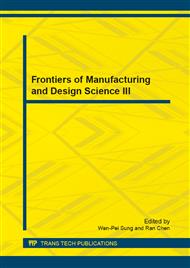p.277
p.283
p.288
p.292
p.297
p.301
p.305
p.310
p.316
The Impact of the Conductive Filler on the Dielectric Properties of Force-Sensitive Conductive Silicone Rubber
Abstract:
Based on the analysis of the conductive mechanism of the conductive rubber used in robot tactile, the paper discussed the influence of the type, particle size and amount of the conductive filler on the dielectric properties of the force-sensitive conductive silicone rubber.Experimental results showed that, for the same mass fraction of the filler material, the particle of bigger size would bring the resistance to decrease more quickly, on the contrary, the smaller one made the the resistance decline.Under the same pressure, with the increase of the amount of graphite filled, the resistivity of the samples would decrease. The resistance of the silicone rubber was changed by the alloy powder added, and the relationship between the tendency of resistance change and the amount of alloy addition was not a single linear, however it significantly increased the range of pressure sensitive of the conductive silicon rubber, and the dielectric properties were improved at the same time.
Info:
Periodical:
Pages:
297-300
Citation:
Online since:
December 2012
Authors:
Price:
Сopyright:
© 2013 Trans Tech Publications Ltd. All Rights Reserved
Share:
Citation:


